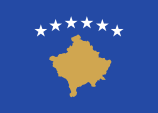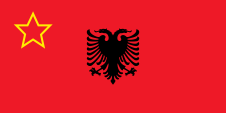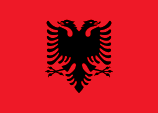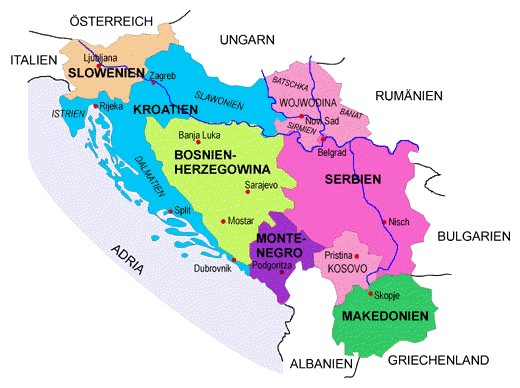Kosovo-Metochien |
|
|
|
| Übersicht – Contents: | |
Kosovo-Metochien |
|
|
|
| Übersicht – Contents: | |
Flagge – Flag: |
Die serbische Provinz Kosovo-Metochien hat keine eigene Flagge. |
sonstige Flaggen – other Flags: |
|
 |
seit/since 17.02.2008, |
 |
ca. 1981–1992, |
 |
Flagge Albaniens – flag of Albania, |
Bedeutung/Ursprung der Flagge – Meaning/Origin of the Flag: |
|
|
Auf Grund bestimmter demographischer Entwicklungen (Albaneranteil: 1918 30%,
1945 50%, 1963 85%) z.B. Umsiedlungsprogramme und die hohe albanische
Geburtenrate, lebten seit etwa 1950 mehr Albaner in der serbischen Provinz
Kosovo als Serben. Dadurch entstanden ethnische Spannungen, die in den
Jahren 1999 und 2000 durch das einseitige Eingreifen der NATO in den
eskalierenden Kosovo-Konflikt zur Vertreibung nahezu der gesamten restlichen
serbischen Bevölkerung führten. Das aufkeimende Nationalbewusstsein der
Albaner in Jugoslawien brachte für die albanische Volksgruppe in diesem Land
eine eigene Flagge hervor. Diese Flagge wurde auch als die inoffizielle
Flagge des Kosovo gesehen, da dort die Albaner mittlerweile in der Mehrheit
sind. Die Flagge wurde auch während der albanischen Unruhen im Jahre 1981
gezeigt. Die Albaner forderten damals auch, dass die damalige autonome
Provinz Kosovo innerhalb der Sozialistischen Föderativen Republik
Jugoslawien (1963–1992) in eine gleichrangige jugoslawische Republik
umzuwandeln sei. Nicht zuletzt deshalb wurde der autonome Status im Jahre
1990 aberkannt. Die Flagge der Kosovo-Albaner zeigt im Prinzip die Flagge Albaniens, jedoch im damaligen jugoslawischen Format von 1:2, ergänzt um einen fünfzackigen, goldumrandeten roten Stern, das Flaggensymbol des sozialistischen Jugoslawien. Mit dem beginnenden Zusammenbruch Jugoslawiens im Jahre 1991 ergab sich aber die Möglichkeit sich komplett von Jugoslawien bzw. Serbien abzuspalten. Am 17.02.2008 wurde einseitig die "Republik Kosovo" proklamiert und eine eigene neue Flagge angenommen. Diese ist einfarbig blau und zeigt in ihrer Mitte eine stilisierte Landkarte des Kosovo, darüber sechs fünfzackige weiße Sterne. Sie stehen für die Ethnien des Kosovo und ergänzen sich mit dem Blau zu einem "europäischen" Design. Die Farben Blau und Gold sind hexadezimal und in CMYK definiert, als Blau = #244AA5 / 100|80|0|0 und Gold = #D0A650 / 0|20|60|20. Daraus lassen sich die Pantone-Farben Blau = pt 294 und Gold = pt 7407 ableiten. |
Because of some demographic developments (Albanian's contingent: 1918 30%,
1945 50%, 1963 85%) e.g. resettlement programs and the high Albanian rate of
birth, lived more Albanians in the Serbian Province of Kosovo as Serbs from
ca. 1950. Thus there came up ethnical tensions, which caused in the years
1999/2000 in the unilateral intervention of the NATO in the escalating
Kosovo Conflict in the expulsion of nearly the whole remaining Serbian
population. The germinating national awareness of the Albanians within Yugoslavia created an own flag for the Albanian ethnic group in this country. The flag was seen as the unofficial flag of the Kosovo too, because the Albanians there are meanwhile in the majority. The flag was also flown during the Albanian riotings in the year 1981. The Albanians also demand at that time that the then autonomous Province of Kosovo within the Socialistic Federative Republic of Yugoslavia (1963–1992) should to be transformed into a of the same rank existing Yugoslav Republic. Not last because of that the autonomous status was repealed in the year 1990. The flag of the Kosovo
Albanians shows in principle the flag of Albania, however in the then
Yugoslav format of 1:2 completed by a five-pointed, gold-rimmed red star,
the flag badge of the socialistic Yugoslavia. With the beginning collapse of
Yugoslavia in the year 1991 there was the possibility to separate oneself
completely from Yugoslavia. The "Republic of Kosovo" was unilateral
proclaimed on 17th of February in 2008 and it was adoped a new flag. It is
single-coloured blue and shows in its middle a stylized map of Kosovo, above
that six five-pointed white stars. They stand for the ethnic groups of
Kosovo and complete together with the clolour blue a "European" design. |
| Quelle/Source: Wikipedia (D), Wikipedia (EN) | |
Landkarten – Maps: |
Lage – Position: |
Landkarte des Landes – Map of the Country: |
Die Staaten des früheren Jugoslawien – The countries of former Yugoslavia: Landkarte/Map: Volker Preuß |
Zahlen und Fakten – Numbers and Facts: |
|
|
|
|
|
|
|
|
|
|
|
|
|
|
|
|
|
Geschichte: |
| Antike · Besiedelung durch thrakische und illyrische Stämme 33–29 v.Chr. · römische Eroberung 395 · bei der Teilung des Römischen Reiches kommt das heutige Kosovo an das Oströmische Reich (Byzanz) 6./7. Jahrhundert · Einwanderung der Serben 12. Jahrhundert · Kosovo ist zentraler Bestandteil des entstehenden Serbischen Reiches 13./14. Jahrhundert · Serbien erobert Makedonien und Bosnien, Epirus, Thessalien und Albanien 1346 · Stephan Dusan wird zum "Kaiser der Serben und Griechen" gekrönt 1355 · Tod von Kaiser Stephan, das Großserbische Reich zerfällt in Einzelstaaten 1371 · die Türken schlagen die Serben an der Maritza 1389 · die Türken schlagen die Serben auf dem Amselfeld, Serbien (und damit Kosovo) wird tributpflichtig, das serbische Fürstentum Zeta (ab 1500 Montenegro genannt) kann seine Unabhängigkeit bewahren 1459 · Serbien wird Teil des Osmanischen Reiches 1690 · erste Vertreibungen von Serben aus dem Kosovo, Albaner rücken aus dem Süden nach 1912–1913 · Balkankriege, das Osmanische Reich muss Kosovo und Nordmakedonien an Serbien abtreten, Kosovo wird serbische Provinz 1918 · Kosovo wird als Teil der serbischen Banschaft (Provinz) Zeta Teil des "Königreichs der Serben, Kroaten und Slowenen", das 1929 zu Jugoslawien umbenannt wird 1941–1945 · Jugoslawien wird im Verlauf des Zweiten Weltkriegs aufgelöst, Serbien (und damit Kosovo) untersteht der deutschen Militärverwaltung 1941–1946 · Jugoslawien ist während des Zweiten Weltkriegs Schauplatz eines erbarmungslosen Partisanen- und Bürgerkriegs zwischen Kommunisten (unter J.P.Tito), Republikanern, Monarchisten und Nationalisten, die Kommunisten setzen sich durch 29.11.1945 · proclamation of the "Federative People's Republic of Yugoslavia" by Tito, Kosovo becomes as a Serbian province part of Yugoslavia 31st of January in 1946 · proclamation of the Republic of Serbia (within communist Yugoslavia) 07.04.1963 · Ausrufung der Sozialistischen Republik Serbien (innerhalb des kommunistischen Jugoslawiens), der Kosovo wird eine autonome Provinz 1974 · Erweiterung der Autonomierechte 1981 · albanische Unruhen, Spannungen zwischen Albanern und Serben, Ausnahmezustand 1990 · Verfassungsreform, der Autonomiestatus des Kosovo wird abgeschafft 1991–1992 · Jugoslawien löst sich in seine Einzelstaaten auf 27.04.1992 · Serbien und Montenegro proklamieren die "Bundesrepublik Jugoslawien" 1991–1995 · Krieg zwischen Jugoslawien und Kroatien/Bosnien-Herzegowina 1998 · im Kosovo forciert die UÇK (Albanische Befreiungsarme des Kosovo) ihren Kampf für die staaliche Unabhängigkeit des Kosovo, auf Grund der serbischen Gegenmaßnahmen fliehen viele Albaner aus Kosovo 1999 · die NATO ergreift einseitig Partei für die UÇK, greift in der Krieg Serbiens um seine territoriale Integrität ein, und bombardiert großangelegt serbische Ziele im Kosovo sowie in Serbien selbst, Besetzung des Kosovo durch KFOR-Truppen der NATO zum "Schutz vor Übergriffen jugoslawischer Truppen", Vertreibung der serbischen Bevölkerung aus dem Kosovo 2002 · die serbische Provinz Kosovo wählt einen "Präsidenten", Ibrahim Rugova 04.02.2003 · neue Verfassung, Jugoslawien wird durch die "Bundesrepublik Serbien und Montenegro" abgelöst 17.02.2008 · der Kosovo erklärt einseitig seine Unabhängigkeit von Serbien (international teilweise Staaten anerkannt) |
History: |
| antiquity · settlement by Thrakian and Illyrian tribes 33–29 B.C. · Roman conquest 395 · at the partition of the Roman Empire comes the today's Kosovo to the East Roman Empire (Byzantium) 6th/7th century · immigration of the Serbs 12th century · Kosovo is a pivotal component of the arising Serbian Empire 13th/14th century · Serbia conquers Macedonia and Bosnia, Epirus, Thessalia and Albania 1346 · Stephan Dusan gets crowned to the "Emperor of the Serbs and Greeks" 1355 · death of Emperor Stephan, the Great Serbian Empire disintegrates into particular states 1371 · the Turks strike the Serbs near the Maritza River 1389 · the Turks strike the Serbs on the Amselfeld, Serbia (and therewith Kosovo) gets a tribute duty, Zeta (since 1500 named Montenegro) can keep its independence 1459 · Serbia becomes a part of the Ottoman Empire 1690 · first expulsions of Serbs from the Kosovo, Albanians move up from the south 1912–1913 · Balkan Wars, the Ottoman Empire has to cede Kosovo and Northern Macedonia to Serbia, Kosovo becomes a Serbian province 1918 · Kosovo becomes as a part of the Serbian Banovina (province) of Zeta a part of the "Kingdom of the Serbs, Croats and Slovenes", which was renamed in 1929 into Yugoslavia 1941–1945 · Yugoslavia gets dissolved during the Second World War, Serbia (and therewith Kosovo) comes under German military government 1941–1946 · Yugoslavia is during the Second World War location of a merciless partisan and civil war between communists (under J.P.Tito), republicans, monarchists and nationalists, the communists prevailed 29th of November in 1945 · Kosovo as Serbian province becomes a part of the by Tito proclaimed "Federative People's Republic of Yugoslavia" 17th of April in 1963 · proclamation of the Socialist Republic of Serbia (within communist Yugoslavia), Kosovo becomes an automomous province 1974 · extension of the autonomy rights 1981 · Albanian riotings, tensions between Albanians and Serbs, state of emergency 1990 · reform of constitution, the autonomy status of the Kosovo is abolished 1991–1992 · Yugoslavia dissolves into its particular states 27th of April in 1992 · Serbia and Montenegro proclaim the "Federal Republic of Yugoslavia" 1991–1995 · war between Yugoslavia and Croatia/Bosnia-Hercegovina 1998 · in Kosovo forces the UÇK (Albanian Liberation Army of the Kosovo) its struggle for the states independence of the Kosovo, because of the Serbian counteractions many Albanians flee from the Kosovo 1999 · the NATO seizes unilaterally party for the UÇK, intervenes in the war of Serbia for its territorial integrity and bombards extendedly Serbian targets in the Kosovo as well as in Serbia itself, occupation of the Kosovo by KFOR-troops of the NATO for "protection against encroachments of Yugoslav troops", assassination and expulsion of the Serbian population from the Kosovo 2002 · the Serbian province Kosovo elects a "President", Ibrahim Rugova 4th of February in 2003 · new constitution, Yugoslavia gets detached by the "Federal Republic of Serbia and Montenegro" 17th of February in 2008 · Kosovo declares unilateral its independence from Serbia (international partially recognized) |
| Quelle/Source: Atlas zur Geschichte, Wikipedia (D), World Statesmen |
Ursprung des Landesnamens – Origin of the Country's Name: |
|
| Der Name "Kosovo" geht auf den serbischen Landschaftsnamen "Kosovo Polje" zurück, das "Amselfeld", eine Landschaft im zentralen Teil des heutigen Kosovo. Metochien ist eigentlich nur der Südwesten des Landes. Der Name ist griechischen Ursprungs und heißt übersetzt "Klostergut". | The name
"Kosovo " goes back to the Serbian landscape name "Kosovo Polje ," the
"Blackbird Field," a landscape in the central part of today's Kosovo. Metohija is actually only the south-west of the country. The name is of Greek origin and is to translate as "Convent's Estate". |
| Quelle/Source: Wikipedia (D) | |
|
Mit freundlicher Untersützung von: Kindly supported by: |
Kurt W. Junges (D) |